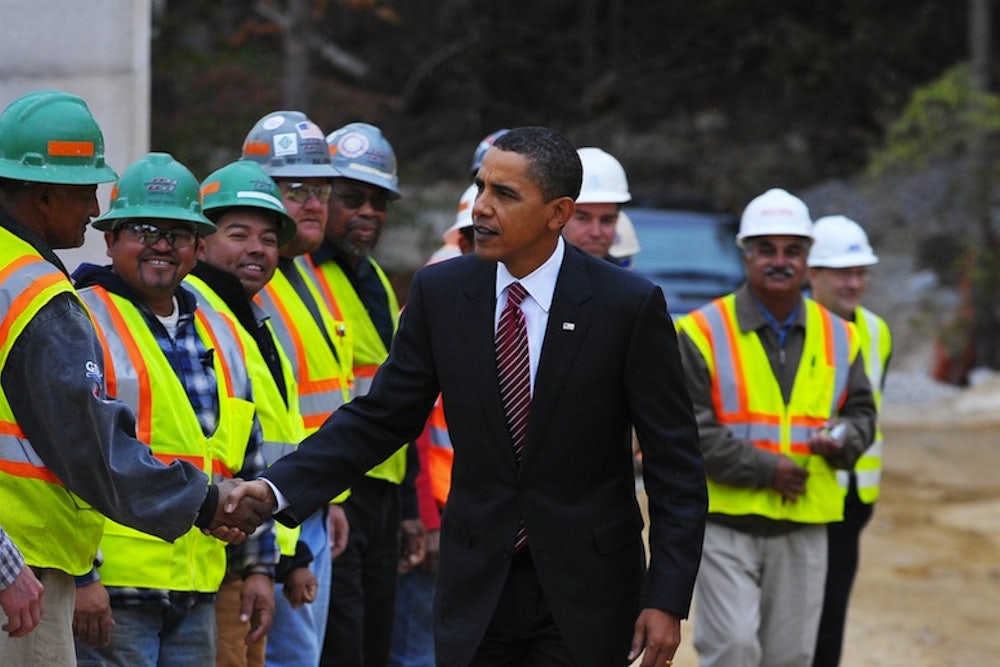President Barack Obama is announcing a $302 billion infrastructure plan Wednesday in St. Paul, Minnesota. The White House is acting like that's a huge sum and its opponents are sure to vilify it for the same reason. But while it's a substantial amount, it's not nearly as big as it sounds—some budget math masks the true size of the investment. But it's more than Republicans are proposing, and while it doesn't solve the underlying problems of our highway funding, it recognizes that the political obstacles of finding a permanent solution are insurmountable right now.
Every year, highway transportation spending is funded through the Highway Trust Fund. Revenue for this fund comes from the gas tax, which has not been updated in decades, causing inflation to slowly eat away at it. That has left the fund with a shortfall in recent years, which Congress has covered by moving money from other parts of the budget. The authorization for that funding expires at the end of September, though, so Congress will have to pass a bill to once again cover the funding gap or the Department of Transportation will have to drastically cut back services.
Over the next four years, the Congressional Budget Office projects that gap to be $61 billion, nearly 30 percent of the Highway Trust Fund's expected outlays ($217 billion). The president's plan covers all of those outlays, including the shortfall, and includes almost $90 billion in additional spending over the next four years, for a cumulative total of $302 billion. Here's how the White House describes it:
"This amount is sufficient to not only fill the current funding gap in the Highway Trust Fund, but increase surface transportation investment over current projected levels by nearly $90 billion over the next four years. When taking into account existing funding for surface transportation, this plan will result in a total of $302 billion being invested over four years putting people back to work modernizing our transportation infrastructure."
Thus, while the proposal represents a $302 billion investment in infrastructure, only $90 billion of it is new spending. The Department of Transportation is already projected to spend the remaining $212 billion without the president's plan. Now, $90 billion is still a substantial sum, but it is not an additional investment of $302 billion. (The White House release is relatively clear on this, but news reporting of it has been less so.) In his budget last year, Obama called for an up-front infrastructure investment of $50 billion. He called for a similar investment in 2010 as well. (Neither happened.)
To put this in perspective, here is both defense and non-defense infrastructure investment as a share of GDP over the past 50 years:

The Congressional Budget Office projects U.S. GDP to be just over $17 trillion next year. If the additional $90 billion in Obama’s infrastructure proposal is divvied up proportionally over the next four years (about $22.5 billion a year), that would increase nondefense infrastructure investment by 0.13 percentage points in 2015. That's nothing to scoff at and his proposal would continue to provide increased funding for three years beyond that, but it is still a smaller up-front investment than Obama proposed in his budget last year.
The cost of the plan will be offset by $150 billion in "pro-growth business tax reform," although the exact details of that are unclear. That's enough to cover the shortfall in highway funding for the next four years as well as the additional $90 billion investment, but it is only a stopgap measure. If Congress passes Obama's plan, the trust fund would still face a shortfall in five years, because additional revenue generated through corporate tax reform is a one-time spending offset. Congress will be back in the same position, trying to scratch together extra funds from other parts of the budget—not that congressional Republicans will ever agree to a permanent solution such as increasing the gas tax and indexing it to inflation. Obama's plan recognizes that political reality and proceeds accordingly. But it is still not a permanent solution to the funding problem of the Highway Tax Fund. In that sense, it only kicks the can down the road once again.
